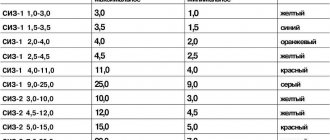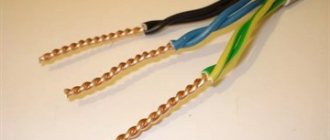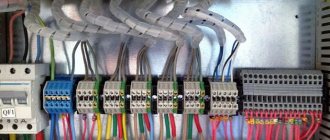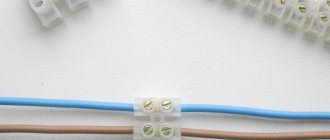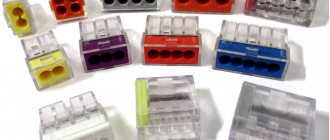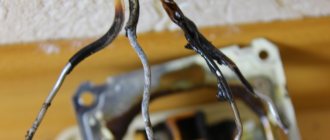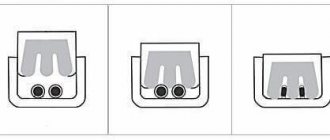What is the best way to connect the wires?
The debate about which wire connection is better continues even among experienced electricians?
To resolve this issue, an objective approach is needed. If we talk about twisting, it has a history from the founding of electrification; this honorable “old man” deserves our great respect! But what was supposed to happen happened, the development of modern technologies is taking over in this field too, meaning the invention of Wago terminal connections, which stepped on the “heels” of twisting and twisting lovers really don’t like it. Vagolyubov can also be reproached for taking an extreme position, since such a connection of wires (Vago terminals) has its drawbacks. which is better to choose a terminal block or twist
A balanced approach to connecting conductors may convince you that these two connections have a right to exist. It is worth noting that the PUE does not welcome twisting, that is, such a scheme - the wires are twisted and insulated, but at the same time, it does not object to soldering and welding twists.
PUE: clause 2.1.21. Connection, branching and terminating of wires and cables must be carried out using crimping, welding, soldering or clamping (screw, bolt, etc.) in accordance with current instructions.
Objects subject to fire inspection are strictly monitored for the presence of wire connections and any twisting is quickly stopped. In other words, most fires occur due to poor-quality connections, in other words, they twist everything that comes to hand, namely: twists consisting of copper and aluminum, soft wire with hard wire, etc. As a result, the twists are poorly compressed, which causes big troubles.
twist
Wago terminals exclude such provocations, but at the same time they are not a panacea and an absolute guarantee of impeccable protection. Wago terminals are designed to withstand a load of 3.5 to 5 kW, depending on the series, therefore, they cannot be installed everywhere. If the terminal melts, it means that, in general, there is an overload on the wiring and the problem lies in a not entirely correctly selected circuit breaker, which should protect against such negative manifestations. Terminal melting problem mainly occurs in old houses where there is no proper control over the wiring and conductor connections.
connecting wires using wago terminals
In modern new buildings, Wago terminals are mainly used and there are no complaints from residents. The fact is that for such consumers as: a boiler, a washing machine, a dishwasher, separate power lines are laid without any connections, and for lighting and socket groups, terminals are used that are not subject to large network overloads.
In other new buildings, twisting is used without soldering and welding, but using PPE terminals, which have proven to be quite reliable terminals. The only drawback of PPE terminals is the large labor costs, in contrast to Wago terminals, which easily and quickly connect wires, and this gives a huge advantage on large objects, where speed and time dictate their own rules.
PPE terminals
Be sure to read detailed articles about connecting wires :
- "Modern methods of connecting wires"
- “Connection of wires in a junction box? SCHEME"
- “PPE caps for twisting wires. Electrician's Tips"
General information about connection methods
Here it’s worth starting with the fact that twisting wires is a connection method that appeared around the same time as electrification itself. However, a huge amount of time has passed since then. Advances in technology have led to the emergence of a newer method - Wago terminal blocks. On the one hand, after such explanations, it becomes very simple to answer the question of which is better - twisting or terminal block. Newer technologies are always ahead of older ones; it is more convenient and practical, as well as more aesthetically pleasing. But in this case, “Vago” also has certain disadvantages.
Today we can say that both methods have the right to exist and be used. However, for example, according to the PUE, ordinary twisting cannot be carried out; it is necessary to carry out either soldering or welding.
When answering the question of which is better - twisting or terminal block, it is necessary to take into account an important fact - where exactly the wires are used. Let's say that the fire inspection at all objects subject to inspection will very quickly stop ordinary twisting. This is due to the fact that very often the cause of a fire is a poor-quality connection. Copper and aluminum wires are twisted together, hard and soft, etc. All this may ultimately cause a fire.
Types of wire connections
The first type is self-clamping terminal blocks. Let's look at this type of connection in more detail. Quite often, when installing electrical wiring, it is necessary to connect aluminum and copper wires with different cross-sections, stiffness and number of cores. But safety precautions strictly prohibit making twists from aluminum and copper materials. Until recently, connections using screws were considered the most reliable, until more convenient Wago spring terminals appeared.
Today, two types of spring connections of this brand are most widespread:
- universal, equipped with a tension spring;
universal clamp
- specialized flat-spring terminals.
The first type is designed for stranded (soft) wires, and the second type is designed only for solid (hard) wires.
PPE type clamps
So, what is more reliable - twisting or terminal block? As noted earlier, you can use a special device for twisting - an insulating connecting clamp or PPE. It can only be used for single-core cables, whose total cross-sectional value will not exceed 20 mm2, and the minimum cross-section will be 2.5 mm2. The body of such devices is usually made of insulating material. It can be polyamide, nylon, fire-resistant PVC. Thanks to this, there is no need for additional subsequent insulation.
The connection occurs according to the following principle: the insulation is removed from the end of the wire by approximately 10-15 mm. The cables are collected into one bundle, and PPE is screwed onto them. It is necessary to screw clockwise until it stops. Caps of this type are very easy to install and quite convenient. But they have a significant drawback - they are much inferior to terminal strips in the quality of twisting, so they are used much less often.
Advantages of Wago connection terminals
Wago spring terminals have many advantages, including:
- The quality of the contact of this terminal does not depend on the qualifications of the technician who performed the wiring.
- The ability to connect quite quickly without using a specialized tool.
- Excellent protection against accidental contact with current-carrying surfaces.
- Highest contact reliability.
- Possibility to make changes to the wiring without breaking the connection.
- Availability of a separate socket for each wire.
- High vibration and impact resistance.
- Automatic control of the clamping force on the wire.
- No need for care or special maintenance.
- The electrical conductors in these terminals have excellent resistance to damage.
- The terminals have a Rostest certificate and permission from Gosenergonadzor.
- Excellent quality/price ratio.
wire clamp
During the installation process, the insulated wire is inserted into the flat-spring drive all the way into the corresponding hole, and at this moment optimal pressure appears on the contact, which does not depend on the cross-sectional area of the conductor. The flat-spring mechanism perfectly presses the wire core to the busbar, which completely eliminates its spontaneous disconnection. To carry out the necessary measurements, there is a special hole in the terminal body that will provide access and visual contact to the electrical bus. When the terminal is connected correctly, the possibility of touching live elements and causing a short circuit is completely eliminated.
reliable wire clamp
If the need arises, you can disassemble the electrical connection; simply pull out the wire with a slight movement, turning it slightly. To remove the flexible conductor, you need to lightly squeeze the terminal, then pull the wire. WAGO terminals allow you to quickly reconnect an electrical circuit without additional stripping of the insulation.
Testing the connection resistance
The test was carried out using a Micromilliohmmeter IKS-1A device. It is designed to determine the electrical resistance of bolted and terminal connectors.
For each connector, pieces of wire with a cross section of 2.5 mm 2 and a length of 3.5 cm each were taken. After this, the device was connected to the two ends of the conductor and a current of 1.2 A was passed through it. Here are the readings:
- Screw terminal block - 40 μOhm.
- PPE - 68 µOhm.
- Twisting - 302 μOhm.
- Wago flat spring clamp - 458 µOhm.
- Construction and installation terminal KBM - 654 μOhm.
In the tests, the screw terminal block performed best. The twist, oddly enough, surpassed Wago and KBM. However, the resistance reading alone is not enough to decide which type of connection is best for wiring. After all, a lot depends on the contact area, and over time, the joint can become clogged with dust and dirt, which will worsen the contact. Let's take a closer look at each type separately.
Some types of Wago terminals
Today, the following types of Wago terminals are most common on the domestic market:
- 1. 773 series is specially designed for use in distribution boxes. Using these terminals you can connect from two to eight wires with a cross-section from 0.75 to 2.5 square meters. mm. They are designed to operate at 400 V. These terminals use a spring-loaded clamp to connect rigid, single-core electrical wires. Most often they use wires with a cross-section of 2.5 and 1.5 square meters. mm.
wago series 773
- 2. Series 273 is also designed for use in junction boxes. These terminals are designed to connect three wires with a cross-section from 1.5 to 4 square meters. mm. They are designed to operate at 400 V. The terminals are complementary to the 773 series, and are typically used to connect wires larger than 2.5 kV. mm.
wago series 273
- 3. 224 series is designed for various lighting applications. These terminals are used to connect two or three wires with a cross-section from 0.5 to 2.5 square meters. mm. They are designed to operate at a voltage of 400 V. These terminals use two types of clamps. Universal clamps are installed on the luminaire side for connecting stranded and fine-core wires, and on the mounting side there are flat-spring clamps for single-core rigid wires. Terminals from this series are specifically designed for lighting, but can be used when installing various devices with flexible wires.
wago series 224
Wago 222 series products
This company produces many varieties of its products. One of the fairly popular series is the Wago 222 terminal block.
This product is intended for connecting or branching both stranded and single-core wires. They are allowed to be used in only alternating electric current circuits with a maximum voltage of 380 V and a frequency of 50 Hz. Initially, the Wago 222 terminal block was intended for switching copper conductors. However, it is also possible to connect aluminum cables if the device is filled with conductive paste. In addition, the equipment is universal, which allows it to be used both for lighting devices and in distribution boards.
As for the external data of the Wago 413 terminal block (full name of the series 222-413), it is very similar to other well-known series such as 273 and 773. It is quite small in size and has good protection of live parts. A small feature of the device is the presence of a test hole. This development is one of the latest, and now it has become very popular in the energy sector. The Wago 2, 3 and 5-wire terminal block is available. In other words, it is possible to connect two, three or five conductors at the same time. It is allowed to switch cables with a diameter from 0.08 to 4 mm2.
The main characteristics of the device are as follows:
- rated operating voltage 400 V or 4 kV;
- rated operating current value for a cable with a diameter of 4 mm2 - 32 A, for a cable 2.5 mm2 - 24 A;
- the cross-section of single-core or stranded conductors should be in the range of 0.08-2.5 mm2;
- connection of fine-wire cables is permitted with a cross-section of 0.08-4 mm2.
Materials used in the manufacture of Wago terminals
In the manufacture of Wago terminals, polyamide is usually used as a material that insulates live parts. It is a poorly flammable, corrosion-neutral material that has self-extinguishing properties. The upper limit of the short-term temperature of polyamide is more than 170 degrees Celsius, and the lower limit is less than - 35 degrees Celsius. Current-carrying elements are made of special electrolytic copper and have a tin-lead coating, which guarantees long-term corrosion protection. When exposed to high specific pressure at the contact point in the clamp, the surface of the conductor is laid in a special lead-tin layer in the contact zone. This guarantees high reliability of protection of the contact point from various corrosive influences.
wago terminal material
The clamps in the spring terminals are made of high quality chromium-nickel steels, which have excellent tensile strength. During the entire period of operation of such materials, not a single case of contact corrosion was detected between the contact materials and the chrome-nickel steel of the spring, which allows the use of Wago terminals even for connecting copper wires.
chromium-nickel steel plates vago reliable spring clamp conductor
Wago construction terminals make it possible, after connecting single-core and stranded wires, if the need arises, to easily change the configuration without using a special tool. Today, Wago terminals are used in construction almost all over the world. The reason for their high popularity lies in their high reliability and ease of installation.
Wago 221 series
The Wago 221 terminal block is a universal lever-type compact connecting device. With its help, you can reliably connect conductors made of copper materials with a diameter of 0.2 to 4 mm2. It is allowed to connect both single-core and multi-core cables. A special feature of the 221 series is that it is perfect for creating both a temporary connection and a permanent one. In electrical engineering, such devices are usually used to connect wires in distribution boards, switchboards or junction boxes.
Another feature of such switching devices is that they are excellent for use both in a regular home network with 220 V or 380 V, and for connecting various components of low-voltage equipment. In addition, this series has a number of certain advantages.
- High speed of installation, which is accompanied by minimal risk of error. Even when assembled by an inexperienced specialist, poor-quality connections are virtually eliminated due to the transparent body and ease of assembly.
- High connection reliability is accompanied by low equipment cost.
- This series of terminals is convenient to use in confined spaces where access to wires is difficult for some reason.
- To set up the connection, you only need to have a minimum kit for stripping the cable insulation. There is no need to use specialized installation equipment.
- As for the rated operating current, for example, it is 32 A. It is also important to note here that if all connection rules are followed, the terminal will not overheat when the current increases above the rated limit.
Twisting of conductors
Due to the relocation of the electric stove in the kitchen, it is not always possible to lay a new power cable, so you have to extend the old one. Some plates can consume up to 7 kW of electricity, and here ordinary twisting is not enough, and soldering or welding conductors is labor-intensive. In this case, it is better to use a terminal block designed for a rated current of 60A to connect the conductors.
What are Vago terminal blocks
Terminal blocks are special screw clamps that are used for reliable electrical connection of conductors (wire, cable, cord). Their use is several times safer than classic twisting or soldering. In this regard, only tips and tinned sleeves can compete with them. Terminal blocks allow you to connect several wires with reliable contact without damaging their open wires.
Terminal block for wires and cables
There are several ways to fasten wires: classic, when they are placed under the head of the fixing bolt, and amateur, when fastening is carried out using a plate or other connectors. Although sometimes they resort to using lugs in difficult situations, it is more convenient to use terminals. They provide reliable and sealed contact and, if used correctly, do not damage the core.
Disposable vaga for soft wire with 3 contacts
For your information! If we talk about “vagi,” then not everyone can immediately understand this term, but in fact everything is simple. This is WAGO nonsense, the name of which has become a household name (by analogy with a photocopier). It is engaged in the production and sale of terminal blocks and is a world leader in this industry.
How to use Wago
The basic rule in working with Vago is the postulate: “One terminal - one contact.” The wires are stripped to 10–12 millimeters. They are then inserted into the connector until the tip rests. If the clamp has a lever, then it must first be opened, and then, when the wire is inserted, the lever snaps into place. Make sure that the exposed wire remains inside the clamp and does not extend beyond it.
Professional electricians recommend:
Do not reuse VAG connectors; if you inserted a wire into a clamp and something went wrong, for example, the exposed part of the conductor was too long, then pull it out, cut it, strip the insulation again and insert it into a new clamp. This approach will guarantee you good contact. In addition, technical Vaseline in the clamps will remain in the required quantities.
Recommendations for installation:
- The total load of all conductors of one line is calculated in advance, and it should not exceed the established values for the connector used.
- Check the following before installation: max. voltage, cross-sectional area, conductor type.
- Recommended for installation in junction boxes only.
- Boxes must be installed in an accessible place so that they can be opened at any time.
- Don't forget to leave extra cable for possible rework. Most electricians recommend leaving 15 cm.
- Marks are usually installed on the connector bodies, which can be used to measure the length of the conductor to be stripped.
- If you need to connect aluminum wires, you need to use technical Vaseline to lubricate the connections, or use Wago, adapted for aluminum.
- For more accurate measurements of indicators, it is recommended to use instruments.
What is the danger of such a connection?
Twisting is the most dangerous way to connect wires, because... in this case, the contact of two or more conductors will depend only on the quality of the work done. If you bend the wires weakly, after a while they will weaken, and a weak contact will form at the point of fastening. With increased current loads, this problem area will begin to constantly heat up, the insulation will begin to melt and as a result a short circuit may occur, not to mention a fire and electric shock to a person.
It is not for nothing that the rules of the PUE strictly prohibit the use of this method in electrical installation work. Despite this, most electricians, and even experienced ones, use this method in everyday repair work.
It should be noted that if you correctly twist the wires together, carefully insulating the exposed area, no problems will arise. Moreover, twisted conductors can last for decades, considering that in most old houses and apartments this method was used.
So, how to twist wires correctly? We'll talk about this now!
Welding copper wires with a graphite electrode
In modern wire joining, carbon electrodes are increasingly being used to weld the ends of copper wires.
This method replaces the outdated method of soldering copper strands. This does not require the use of solder or flux. The task of welding is the same as with soldering - it is to ensure reliable and durable contact between two or even several wires, since this cannot be achieved with a conventional connection. Over time, a film will certainly appear on the surface of copper due to oxidation. After the welding process, the junction of the cores is welded differently than during soldering; soldering occurs only at the tip. However, even such formed contact at an increased load prevents overheating of the welded cable cores.
Graphite electrode for welding
Due to its technical characteristics, the graphite electrode is easy to cut , consumes more slowly, and does not crack during welding.
As practice shows, welding of wire cores is carried out in distribution boxes. The boxes are located quite high, so you will need to use portable welding equipment for welding.
Industrial devices are used for these purposes, the use of which is advisable in a professional sense. If possible, you can assemble the welding machine yourself. However, for most people, inverter-type devices, which are presented in a large assortment in stores, are perfect. They are compact, mobile, lightweight and also have the ability to adjust the welding current you need.
Types of electrodes for welding copper wire cores
When welding copper conductors, appropriate electrodes . We have already mentioned carbon electrodes. There is also a graphite type of electrodes. Battery rods, brushes of commutator motors and similar products made of graphite can be used as an electrode in household use.
Graphite rods are a good replacement for purchased electrodes, with the only exception that they do not have copper plating, but this can be solved by improving the holder. To do this, it will be necessary to use an alligator clip, both for the electrode and for the ground connection. They will not be as bulky as standard ones, so it will be more convenient for you to work in switchboards. Of course, you will need to take care of additional insulation of the handles.
Graphite and carbon electrodes have a general similarity: both have a melting point 4 times higher than the melting threshold of copper itself. Because of this property, the consumption of electrodes when connecting electrical wiring is very low.
Please note that the electrode heats up to a high temperature instantly, so there is a risk of overheating the material you are welding, which, in turn, can damage the insulation in the cable. The welder needs to know these factors in order to be careful when installing electrical wiring.
Differences between graphite and carbon electrodes
Despite the similarity of graphite and carbon rods when installing wiring, their characteristics differ:
- The first difference is the price. Graphite products are more affordable;
- if the carbon rod is completely black, then the graphite electrode has a gray-dark color with a metallic tint;
- welding using a carbon electrode requires a certain skill from the welder, since the carbon rod creates an arc of enormous temperature, which can lead to the destruction of the welded twist. At the same time, huge temperature indicators occur at low current. Based on this, carbon electrodes will be useful to a welder with a weak welding machine;
- for those who own an inverter device that is equipped with a current regulator, it is better to use graphite rods. When working with them, less skilled craftsman is required. In addition, the connection of wire cores after their use is characterized by greater strength, better quality, and increased resistance to oxidation than after the carbon welding process.
Adjusting the current during welding
Current adjustment during wire welding occurs in the range from 30 to 120 amperes (most inverter welding machines operate in this range). In any case, you will have to empirically select the exact welding current , since:
- Each inverter has its own characteristics.
- Your network voltage may not correspond to 220 Volts.
- The chemical composition of copper wire strands may vary due to different manufacturers.
- In addition, it won’t hurt you to practice so that the work is completed as efficiently and quickly as possible.


